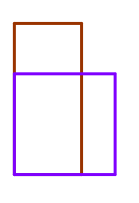I attended the San Francisco Math Teachers’ Circle last weekend. It was facilitated by Paul Zeitz. The topic: showing two polygons have equal area by cutting one into pieces, and rearranging them to cover the other one with no gaps or overlaps.
The assumption was that the area of a rectangle is length times width. The warmup was to use that assumption and scissors to derive formulas for the area of the triangle and the parallelogram. This reminded me of the activity Rachel Chou and I prepared for our Hands On Geometry workshop last summer. We asked participants to find a formula for the area of a trapezoid using a strategy based on adding and subtracting pieces. We had come up with nine different ways to do it, and if I remember correctly, one of the workshop participants found a tenth.


Nice, no? Why does it work, you ask? Understanding that requires familiarity with the theorem of Thales, and what I call “the three triangles”. (The relationships created when dropping an altitude onto the hypotenuse of a right triangle.)
See if this figure makes it clear:
